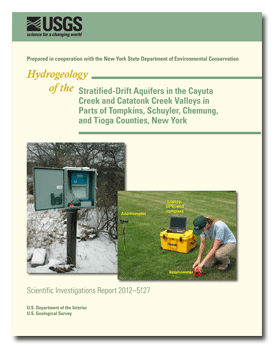 Abstract Abstract
The surficial deposits, areal extent of aquifers, and the water-table configurations of the stratified-drift aquifer systems in the Cayuta Creek and Catatonk Creek valleys and their large tributary valleys in Tompkins, Schuyler, Chemung, and Tioga Counties, New York were mapped in 2009, in cooperation with the New York State Department of Environmental Conservation. Well and test-boring records, surficial deposit maps, Light Detection and Ranging (LIDAR) data, soils maps, and horizontal-to-vertical ambient-noise seismic surveys were used to map the extent of the aquifers, construct geologic sections, and determine the depth to bedrock (thickness of valley-fill deposits) at selected locations. Geologic materials in the study area include sedimentary bedrock, unstratified drift (till), stratified drift (glaciolacustrine and glaciofluvial deposits), and recent alluvium. Stratified drift consisting of glaciofluvial sand and gravel is the major component of the valley fill in this study area. The deposits are present in sufficient amounts in most places to form extensive unconfined aquifers throughout the study area and, in some places, confined aquifers. Stratified drift consisting of glaciolacustrine fine sand, silt, and clay are present locally in valleys underlying the surficial sand and gravel deposits in the southern part of the Catatonk Creek valley. These unconfined and confined aquifers are the source of water for most residents, farms, and businesses in the valleys.
A generalized depiction of the water table in the unconfined aquifer was constructed using water-level measurements made from the 1950s through 2010, as well as LIDAR data that were used to determine the altitudes of perennial streams at 10-foot contour intervals and water surfaces of ponds and wetlands that are hydraulically connected to the unconfined aquifer. The configuration of the water-table contours indicate that the general direction of groundwater flow within Cayuta Creek and Catatonk Creek stratified-drift aquifers is predominantly from the valley walls toward the main streams in the valleys. The groundwater discharges from the aquifer system to the main-stem streams in the valleys. Locally, the direction of groundwater flow is radially away from groundwater mounds that have formed beneath upland tributaries that typically lose water where they flow on alluvial fans in the valleys. In some places, groundwater that would normally flow toward streams is intercepted by pumping wells.
|
First posted August 21, 2012
Part or all of this report is presented in Portable Document Format (PDF); the latest version of Adobe Reader or similar software is required to view it. Download the latest version of Adobe Reader, free of charge. |